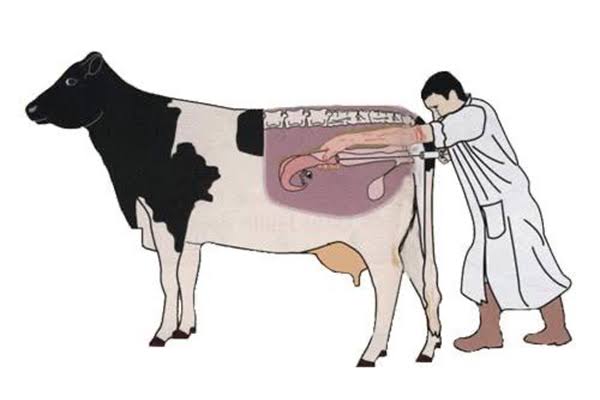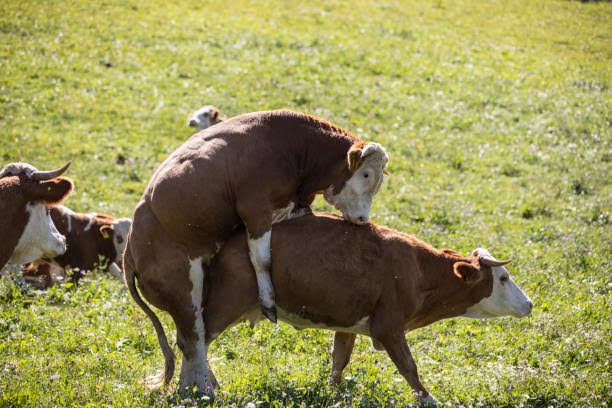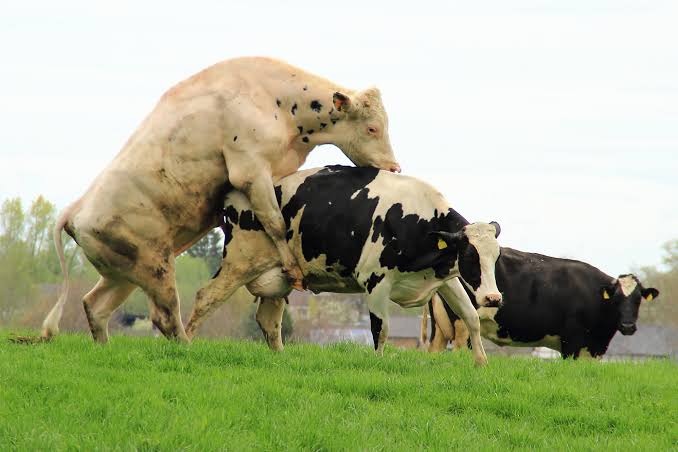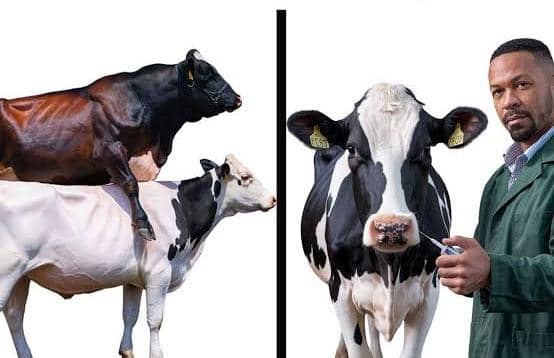Natural mating and artificial insemination are two central approaches to breeding animals, both widely used in animal husbandry for the propagation and improvement of livestock.
The natural mating and artificial insemination have been instrumental in ensuring the successful reproduction of domesticated animals across various species, from cattle and poultry to sheep, goats, and even exotic animals.
Each approach plays a critical role in achieving reproductive success, but they operate differently and have unique impacts on breeding practices, animal welfare, and genetic improvement. Natural mating is the traditional and instinctive method of reproduction in animals.
It involves the physical copulation between a male and a female of the same species, where sperm is transferred from the male to the female during sexual intercourse. This process occurs naturally, with little to no human intervention, and is governed by the reproductive cycles of the animals.
In natural mating, the male and female must be present in the same location, and the act is typically initiated by behaviors that signal readiness for reproduction, such as courtship rituals or physical signs of heat in females.
For farmers and animal breeders, natural mating is often seen as the most straightforward approach to reproduction. It requires no specialized equipment or expertise, making it accessible even in remote or low-resource farming environments.
Natural mating occurs in animals when the conditions are right—usually when the female is in estrus, the phase of the reproductive cycle when she is most fertile and receptive to the male’s advances.
This method is particularly common in smaller, more traditional farming operations, where herds and flocks are allowed to reproduce with minimal management and oversight. One of the key advantages of natural mating is its simplicity.
Animals are left to reproduce based on their instincts, and as long as the male and female are healthy and fertile, reproduction can occur naturally. Additionally, it ensures genetic diversity in wild and farmed populations, as animals typically mate with multiple partners over their reproductive lifetimes.
This genetic diversity is critical for the health and resilience of populations, especially in wild species or in extensive farming systems where selective breeding is less emphasized. However, natural mating is not without its challenges.
In certain controlled breeding programs, where the goal is to improve specific traits or to increase the genetic superiority of livestock, natural mating may be less efficient. One issue with natural mating is the limited number of females a single male can mate with during a breeding season. In large-scale operations, where many females need to be bred, relying solely on natural mating may result in lower productivity.
Furthermore, natural mating can expose animals to certain risks, such as injuries during mating, transmission of diseases, and the possibility of unwanted pregnancies in unmonitored herds. As agriculture has become more specialized, artificial insemination has emerged as a modern alternative to natural mating.
Artificial insemination (AI) involves collecting semen from a male and manually inserting it into the reproductive tract of a female. This method allows for greater control over the breeding process and has become a favored practice in industries such as dairy, beef, and swine production.
One of the primary reasons for the rise of AI is its ability to overcome some of the limitations of natural mating, particularly in terms of efficiency and genetic management. Artificial insemination allows breeders to use semen from a single, high-quality male to fertilize numerous females across different locations, even without the male being physically present.
This has revolutionized livestock breeding, enabling the widespread dissemination of desirable genetic traits from superior sires. For instance, in dairy farming, semen from a bull known for producing daughters with high milk yield can be used to impregnate thousands of cows, leading to significant improvements in the overall productivity of the herd.
AI also reduces the risk of transmitting diseases between animals, as there is no direct contact between the male and female during the process. In addition, semen can be collected, frozen, and stored for long periods, allowing for genetic material to be preserved and transported globally. This has been especially important for rare or endangered species, where maintaining genetic diversity is crucial for species survival.
Despite its advantages, artificial insemination requires a higher level of technical knowledge and resources compared to natural mating. Farmers or breeders must be trained in semen collection and insemination techniques, and the timing of the procedure is critical for its success. The female must be inseminated when she is in estrus to maximize the chances of fertilization.
For this reason, AI is often used in more intensive, commercial farming operations where the costs of equipment and training can be justified by the potential increase in productivity and genetic improvement.
Artificial insemination has also allowed for more selective breeding practices. With AI, breeders can choose the best males based on specific traits they want to pass on to their offspring. This selective approach has been key in improving the genetic quality of livestock, leading to animals that are more productive, resilient, and well-suited to the demands of modern agriculture.
Traits such as increased milk production in dairy cattle, faster growth rates in beef cattle, and greater reproductive efficiency in pigs are just a few examples of the improvements that have been achieved through the use of AI.
In certain cases, artificial insemination has been combined with other reproductive technologies, such as embryo transfer and genetic testing, to further enhance breeding outcomes. This integrated approach allows breeders to not only control which animals reproduce but also to select the best embryos for implantation based on genetic merit.
As a result, AI has become a cornerstone of modern breeding programs, helping to meet the growing global demand for food and agricultural products. Natural mating and artificial insemination both play important roles in the reproduction of animals, with each method offering distinct benefits and challenges.
While natural mating continues to be a vital part of reproduction in many traditional and low-tech farming systems, artificial insemination provides a more controlled and efficient means of managing livestock breeding in modern agricultural settings. T
he choice between these two methods depends on various factors, including the size of the operation, the goals of the breeding program, and the available resources and expertise.
Read Also: Ogbono Plant Uses in Herbal Medicine
Key Differences Between Natural Mating and Artificial Insemination

Breeding methods have evolved over time, providing farmers and breeders with various techniques to optimize livestock reproduction. Two of the most common methods are natural mating and artificial insemination (AI). Understanding the differences between these methods is essential for choosing the right approach depending on the goals, scale of the operation, and the desired outcomes.
While both aim to achieve successful fertilization and reproduction, they differ in terms of how they are carried out, the level of human intervention required, and their impact on genetic selection and livestock management.
1. Definition and Process: The first major distinction between natural mating and artificial insemination lies in how each method is conducted. In natural mating, reproduction occurs through the physical interaction between a male and female.
This traditional method relies on the natural instincts of the animals, where the male mounts the female and transfers sperm through direct contact during mating. It is a process that involves little to no human intervention, except for managing the animals’ environment and ensuring that mating partners are together during the female’s estrous cycle.
On the other hand, artificial insemination involves a more controlled and technical process. AI requires the collection of semen from the male, which is then processed and manually introduced into the female’s reproductive system.
This method allows for greater control over the timing, selection of genetic material, and the specific pairing of traits. AI is carried out by trained personnel who monitor the female’s reproductive cycle closely to ensure insemination happens during her most fertile period. As a result, AI requires more specialized equipment and knowledge compared to natural mating.
2. Genetic Selection and Improvement: One of the most significant advantages of artificial insemination over natural mating is its ability to enhance genetic selection. With AI, breeders can carefully select sperm from genetically superior males, ensuring that desirable traits such as higher milk production, faster growth rates, disease resistance, or better meat quality are passed on to future generations.
This method allows for the rapid improvement of specific traits across a population, as a single male can inseminate hundreds or even thousands of females through the storage and distribution of semen.
In contrast, natural mating is more limited in its capacity for genetic improvement. The male can only mate with a limited number of females, which slows down the process of passing on desirable traits. Additionally, natural mating doesn’t offer the same level of control over genetic selection.
In many cases, mating is random, leading to a more diverse genetic pool but without the focused enhancement of specific characteristics. However, this diversity can be beneficial in terms of overall herd health and adaptability to changing environmental conditions.
3. Efficiency and Scale: Efficiency is another key area where natural mating and artificial insemination differ significantly. Natural mating is simpler and more cost-effective, especially for smaller-scale operations or traditional farms where the investment in AI technology and training may not be practical.
However, the efficiency of natural mating is limited by the physical capacity of the male. A male can only mate with a certain number of females, and factors such as fertility, health, and timing can impact the success of reproduction.
In contrast, artificial insemination is highly efficient, especially for large-scale breeding operations. By collecting and storing semen, AI allows a single male to inseminate far more females than would be possible through natural mating.
This increases the efficiency of breeding programs, making AI the preferred method for many commercial livestock operations. Furthermore, semen can be transported long distances, enabling breeders to access superior genetics from around the world without moving the animals themselves.
4. Disease Control: Another important factor to consider when differentiating between natural mating and artificial insemination is disease control. Natural mating involves direct physical contact between the animals, which can increase the risk of transmitting sexually transmitted diseases (STDs) or other infections.
These diseases can have a significant impact on the reproductive health of both males and females, potentially reducing fertility rates and increasing the risk of complications during pregnancy or birth.
On the other hand, artificial insemination minimizes the risk of disease transmission because there is no direct contact between the animals. The semen used in AI is often screened for diseases before it is processed and stored, ensuring that only healthy genetic material is used.
This controlled process helps protect the reproductive health of the female, making AI a safer option in terms of disease management, especially in large breeding programs where disease outbreaks can have widespread consequences.
5. Cost and Investment: The cost of implementing natural mating versus artificial insemination is another key difference. Natural mating generally involves lower upfront costs because it does not require specialized equipment, facilities, or training. For smaller farms or breeders with limited resources, this method is often more practical.
The costs are mainly associated with the care and maintenance of the breeding male and the management of the herd. In contrast, artificial insemination requires a higher initial investment in terms of equipment, facilities, and training for personnel. Semen collection, storage, and the actual insemination process all require specialized skills and equipment, which can be costly.
Additionally, breeders may need to invest in hormone treatments to synchronize the estrous cycles of the females, ensuring that insemination takes place at the optimal time. However, the long-term benefits of AI, such as improved genetics, higher fertility rates, and disease control, often outweigh the initial costs, especially in large-scale operations.
6. Timing and Control: One of the limitations of natural mating is that it depends heavily on the timing of the female’s estrous cycle. The success of fertilization relies on the male being available and ready to mate when the female is in heat, which requires careful monitoring of the animals. Additionally, natural mating does not allow for precise control over the timing of fertilization, which can lead to variations in the success rate.
In contrast, artificial insemination provides breeders with greater control over the timing of fertilization. By closely monitoring the female’s estrous cycle and using hormonal treatments if necessary, breeders can ensure that insemination occurs during the optimal window for fertility.
This control over timing increases the likelihood of successful fertilization, making AI a more reliable method for planned breeding programs. The ability to store semen also allows for flexibility in timing, as breeders can choose when to inseminate based on the needs of the operation.
7. Reproductive Health and Longevity: Lastly, the impact of each method on the reproductive health and longevity of the animals is another important factor to consider. Natural mating can sometimes lead to physical injuries for both males and females, especially in larger species where the mating process can be physically demanding.
Over time, these injuries can reduce the reproductive lifespan of the animals, limiting the number of offspring they can produce. Artificial insemination, on the other hand, reduces the risk of physical injury because there is no direct contact between the animals during the breeding process.
This can help extend the reproductive lifespan of both males and females, allowing them to produce more offspring over their lifetime. Additionally, AI enables the use of older males whose physical ability to mate may have declined but who still produce viable semen.
Advantages and Disadvantages of Natural Mating and Artificial Insemination in Animal Breeding

Natural mating and artificial insemination (AI) both have their advantages and disadvantages, and their effectiveness depends on the breeding program’s goals, available resources, and operational scale.
Natural Mating: Advantages
1. Simplicity and Low Cost: One of the primary advantages of natural mating is its simplicity. In this method, animals are left to mate naturally without much human intervention.
This makes it a cost-effective option, especially for small-scale farms or traditional livestock operations. The process requires no specialized equipment, semen storage, or complex procedures, reducing the need for investment in infrastructure or veterinary services.
Moreover, natural mating doesn’t require the technical knowledge necessary for semen collection, processing, and insemination. Farmers or breeders do not need to undergo specialized training to perform the breeding process, which is beneficial for those working with limited resources.
2. Genetic Diversity: Natural mating contributes to greater genetic diversity within a herd. When animals mate naturally, there’s a broader chance of genetic variation due to the random pairing of male and female animals.
This diversity can be an advantage in maintaining herd health, as it reduces the risk of inbreeding and its associated genetic disorders. In cases where environmental adaptability is a priority, genetic diversity helps animals become more resilient to changing conditions and diseases.
3. Natural Reproductive Behavior: Natural mating allows animals to exhibit their natural reproductive behaviors, which can be beneficial for animal welfare. The process is natural and instinctive, contributing to a less stressful experience for the animals. For animals that thrive in more traditional or free-range environments, natural mating is a more harmonious and less intrusive method.
Natural Mating: Disadvantages
1. Limited Genetic Improvement: While natural mating offers genetic diversity, it lacks the precision required for targeted genetic improvement. Breeders have limited control over the selection of desirable traits because natural mating relies on chance pairings.
This means that improving specific traits, such as faster growth, higher milk production, or better disease resistance, takes longer compared to more controlled methods like artificial insemination. Over time, this can slow the overall genetic progress of the herd.
2. Risk of Disease Transmission: Natural mating involves physical contact between animals, which increases the risk of sexually transmitted diseases (STDs) and infections.
Diseases such as brucellosis and trichomoniasis can spread through direct contact during mating, which can negatively impact the reproductive health of both males and females. Disease outbreaks in herds can lead to significant economic losses and reduced reproductive success.
3. Physical Limitations: Natural mating is limited by the physical capacity of the breeding male. A single male can only mate with a certain number of females, which reduces the number of offspring produced in a given time period.
Additionally, factors such as age, health, and fertility can affect the male’s ability to mate successfully. Injuries to either male or female animals during the mating process can also reduce reproductive efficiency.
Artificial Insemination: Advantages
1. Controlled Genetic Selection: One of the most significant advantages of artificial insemination is the control it offers over genetic selection. AI allows breeders to select sperm from males with desirable traits such as superior milk production, meat quality, disease resistance, or faster growth rates.
By using semen from genetically superior males, AI accelerates genetic improvement across the herd. This precision is especially important for commercial livestock operations focused on improving productivity and profitability.
AI also enables breeders to use semen from males that are located far away, allowing for access to the best genetics from across the world. This would be impossible or highly impractical with natural mating, where the animals must be in close proximity.
2. Higher Reproductive Efficiency: AI enables a single male to inseminate a large number of females, far more than would be possible through natural mating. Semen can be collected, processed, and stored for extended periods, allowing for multiple inseminations from a single collection.
This increases reproductive efficiency and allows for larger-scale breeding programs. Moreover, AI can be timed precisely to the female’s estrous cycle, maximizing the chances of successful fertilization.
3. Disease Control: Because artificial insemination does not require direct physical contact between animals, it significantly reduces the risk of disease transmission. Semen is collected in controlled environments, and in most cases, it is screened for diseases before use.
This ensures that only healthy genetic material is used in the breeding process, protecting the reproductive health of the females. This is particularly important in large-scale operations where a single outbreak could have devastating consequences.
4. Flexibility and Timing: AI provides breeders with flexibility in terms of timing and planning. Semen can be stored and used when needed, allowing breeders to plan for optimal breeding times. AI also enables synchronization of breeding, where females are treated with hormones to synchronize their estrous cycles.
This ensures that insemination occurs at the most fertile period, increasing the likelihood of conception. This level of control is not possible with natural mating, where timing can be unpredictable.
Artificial Insemination: Disadvantages
1. Higher Costs and Investment: One of the main drawbacks of artificial insemination is the higher cost associated with its implementation. AI requires specialized equipment, facilities for semen storage, and trained personnel to carry out the procedure.
The cost of semen from genetically superior males can also be significant, depending on the breed and the traits being selected. While the long-term benefits of AI may outweigh the costs in large-scale operations, small farms may find the upfront investment prohibitive.
2. Need for Skilled Personnel: Artificial insemination requires a level of technical expertise that is not needed for natural mating. Farmers or breeders must be trained in semen collection, processing, storage, and insemination techniques.
This adds a layer of complexity to the breeding process, which may be challenging for those who do not have access to trained personnel or veterinary services. Improper handling of semen or incorrect timing of insemination can result in failed breeding attempts and economic losses.
3. Reduced Genetic Diversity: While AI allows for targeted genetic selection, it can also lead to reduced genetic diversity if only a few males are used extensively across large populations.
Over-reliance on a small pool of genetically superior males can result in inbreeding, which increases the risk of genetic disorders and reduces the adaptability of the herd. Breeders must carefully manage AI programs to avoid overusing certain genetic lines and ensure that genetic diversity is maintained.
Read Also: Ogbono Plant and Weight Loss Benefits
Frequently Asked Questions on the Differences Between Natural Mating and Artificial Insemination

1. What is the primary difference between natural mating and artificial insemination?
Natural mating involves direct physical contact between a male and female animal for reproduction, while artificial insemination (AI) is a controlled method where semen is collected from a male and manually inserted into the female’s reproductive tract.
2. Which method is more effective for genetic improvement, natural mating or artificial insemination?
Artificial insemination is more effective for genetic improvement since breeders can select semen from superior males with desirable traits, whereas natural mating relies on random pairings.
3. Can artificial insemination increase the risk of inbreeding?
Yes, if artificial insemination uses semen from a limited number of males extensively, it can lead to reduced genetic diversity and increase the risk of inbreeding.
4. Which method has a lower risk of disease transmission, natural mating or artificial insemination?
Artificial insemination has a lower risk of disease transmission since there is no physical contact between animals, and semen is typically screened for diseases.
5. How does reproductive efficiency differ between natural mating and artificial insemination?
Artificial insemination offers higher reproductive efficiency because semen from one male can be used to inseminate multiple females, while natural mating is limited by the physical capacity of the male.
6. Do animals show better welfare in natural mating compared to artificial insemination?
Natural mating allows animals to exhibit their natural reproductive behaviors, which can be beneficial for their welfare, whereas artificial insemination involves more human intervention.
6. Is artificial insemination suitable for all types of animals?
Artificial insemination is widely used in many species, but it may not be as commonly used or effective for smaller or more challenging species.
8. Which method is more commonly used in large-scale commercial livestock operations?
Artificial insemination is more commonly used in large-scale commercial livestock operations due to its efficiency and ability to improve genetics.
9. How does the timing of reproduction differ in natural mating and artificial insemination?
Natural mating relies on animals’ natural breeding cycles, while artificial insemination can be timed precisely to a female’s estrous cycle.
10. Can AI be used for selective breeding across long distances?
Yes, AI allows for semen from genetically superior males to be transported across long distances, providing access to a wider genetic pool.
11. Which method is better for managing the breeding of endangered species?
Artificial insemination can be better for managing endangered species because it allows for careful genetic selection and minimizes disease transmission.
12. How do the equipment and technical skills needed compare between the two methods?
Natural mating requires minimal equipment and expertise, while artificial insemination requires specialized equipment and trained personnel.
13. Which method is more likely to result in injuries during the breeding process?
Natural mating can sometimes result in injuries due to aggressive behavior between animals, whereas artificial insemination reduces this risk by eliminating physical interaction.
Read Also: How to Make Homemade Pasta
Do you have any questions, suggestions, or contributions? If so, please feel free to use the comment box below to share your thoughts. We also encourage you to kindly share this information with others who might benefit from it. Since we can’t reach everyone at once, we truly appreciate your help in spreading the word. Thank you so much for your support and for sharing!

